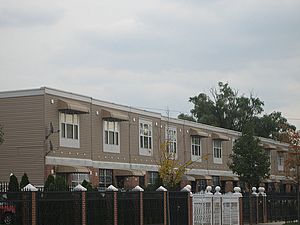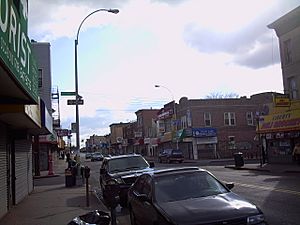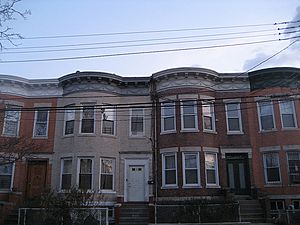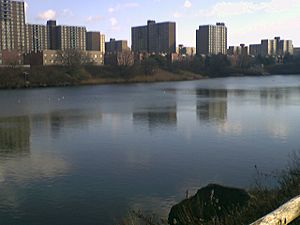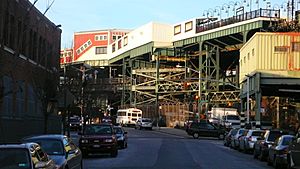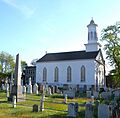East New York, Brooklyn facts for kids
Quick facts for kids
East New York
|
|
|---|---|
|
Neighborhood of Brooklyn
|
|

Typical multi-unit semi-detached rowhouses
in East New York |
|
| Nicknames:
EastNY, East Brooklyn
|
|
| Country | |
| State | |
| City | New York City |
| Borough | Brooklyn |
| Community District | Brooklyn 5 |
| Area | |
| • Total | 4.84 km2 (1.867 sq mi) |
| Population
(2010)
|
|
| • Total | 91,958 |
| • Density | 19,017/km2 (49,254/sq mi) |
| Ethnicity | |
| • Black | 63.6% |
| • Hispanic | 29.6 |
| • Asian | 3.0 |
| • White | 1.3 |
| • Other | 2.5 |
| Economics | |
| • Median income | ,786 |
| Time zone | UTC−5 (Eastern) |
| • Summer (DST) | UTC−4 (EDT) |
| ZIP Codes |
11207, 11208, 11239
|
| Area codes | 718, 347, 929, and 917 |
East New York is a lively residential neighborhood in the eastern part of Brooklyn, New York City. It's bordered by the Cemetery Belt and the Queens line to the north, the Queens line to the east, Jamaica Bay to the south, and the Bay Ridge Branch railroad tracks and Van Sinderen Avenue to the west. Important roads like Linden Boulevard, Pennsylvania Avenue, and Atlantic Avenue run through the area.
East New York was first settled in the 1650s as the Town of New Lots. It became part of the growing City of Brooklyn in 1886 and then joined New York City in 1898. Over time, many African Americans and Latinos made East New York their home.
Today, East New York is part of Brooklyn Community Board 5. Its main ZIP Codes are 11207, 11208, and 11239. The New York City Police Department's 75th Precinct patrols the area, and the Fire Department of New York provides fire safety.
Contents
History of East New York
Early Beginnings and Growth
The northern edge of East New York has a chain of hills, which are natural formations. The southern parts of the neighborhood used to be salt marshes and creeks that flowed into Jamaica Bay. The Jameco Native Americans first lived here, and later the Canarsee and Rockaway tribes used the area for fishing.
In the 1650s, Dutch settlers started moving into eastern Brooklyn. They formed towns like Flatbush, Bushwick, and New Lots (which became East New York). In 1664, the area became part of the British Empire. Some old roads, like the Palmer Turnpike from Brooklyn to Jamaica, went through the hills. This area was known as "Jamaica Pass". During the American Revolutionary War in 1776, British and Hessian soldiers marched through this pass to surprise George Washington's army, leading to the Battle of Long Island.
In 1835, a merchant named John Pitkin bought land north of New Lots Avenue. He built a shoe factory and named the area "East New York" because it was the eastern edge of New York City. The Long Island Rail Road (LIRR) opened a line through the area in 1836, adding a stop in East New York by 1844.
Later, more transit lines like the BMT Jamaica Line and the Fulton Street Line (elevated) were built, helping the area grow. East New York (then called New Lots) became part of the City of Brooklyn in 1886. In 1898, Brooklyn and other areas joined to form the "City of Greater New York".
After World War II, many factory jobs left New York City. At the same time, many Puerto Ricans and African Americans moved to the city looking for work. East New York faced challenges like job shortages.
Community Efforts and Renewal
In the 1970s, East New York faced tough times, with many homes becoming empty. A special study was done to understand what happened. It showed that changes in housing programs led to problems, and many homes were bought and sold in ways that made it hard for new homeowners to keep them. This led to many homes being abandoned or foreclosed.
To help the neighborhood, plans were made to rebuild. A program called SHIP (Small Home Improvement Program) was started to fix up homes and sell them at affordable prices to families with lower incomes. This program helped renovate many houses.
Later, many of the old, empty houses were replaced with new ones. New apartment buildings and townhouses were also built on empty lots. In the 1980s, a group called East Brooklyn Congregations (EBC) worked to create affordable housing. They started the Nehemiah Program, which built new homes on city-owned land. This program helped many families become homeowners.
New shopping areas have also been built, like the Gateway Center shopping mall near Jamaica Bay. This mall has many popular stores and restaurants, like ShopRite, Target, and The Home Depot.
People and Demographics
Based on the 2010 United States census, East New York had 91,958 people. This was an increase of over 8,000 people since the 2000 census.
The neighborhood is very diverse. In 2010, about 63.6% of residents were African American, 29.6% were Hispanic or Latino, 3.0% were Asian, and 1.3% were White.
Most people in East New York are middle-aged adults and young people. About 27% are under 18, and 28% are between 25 and 44. The average life expectancy in the area is 78.6 years.
In 2016, the average household income was $36,786. About 30% of residents live in poverty, which is higher than the average for Brooklyn and New York City. Many residents (52%) also spend a large part of their income on rent.
Over the years, East New York has become home to many different groups, including African American, Puerto Rican, Dominican, West Indian, and South Asian populations.
Geography and Land Use
What East New York Looks Like
East New York has many different types of buildings. You'll find semi-detached homes, houses for two to four families, and larger apartment buildings. The total land area is about one square mile.
The area is also home to the East Brooklyn Industrial Park, a 44-block area for businesses and factories. There are also twelve New York City Housing Authority (NYCHA) public housing developments in East New York, with buildings of different sizes.
Since 1998, the East New York Farms project has helped create many community gardens on empty lots, making the area more beautiful. In 2013, African Burial Ground Square was recognized after old remains were found. It's a special place that shares space with the New Lots branch of the Brooklyn Public Library.
Neighborhood Sections
City Line
City Line is a part of East New York that borders Cypress Hills to the north, Ozone Park (in Queens) to the east, and Conduit Boulevard to the south. It's called "City Line" because it was near the border of the old City of Brooklyn and Queens before they both became part of New York City in 1898. City Line is known for being very diverse, with people from many different backgrounds living there today. The main shopping street is Liberty Avenue.
New Lots
New Lots is another part of East New York. It was first settled in the 1700s. From 1852 to 1886, it even had its own Town Hall. Today, many African Americans and Hispanic Americans live here. It's part of Brooklyn Community Board 5.
Spring Creek
Spring Creek is in the southeastern part of East New York. It includes the large Starrett City apartment complex, the Gateway Mall, and other housing developments. It's bordered by Flatlands Avenue to the north, Betts Creek and Fountain Avenue to the east, Gateway National Recreation Area to the south, and Schenck Avenue and Hendrix Creek to the west.
Cypress Hills
Cypress Hills is a section of East New York. It's bordered by City Line to the south, Cypress Hills Cemetery to the north, Bushwick to the west, and Woodhaven and Ozone Park in Queens to the east. It's a mixed neighborhood with many different ethnic groups. There's a Brooklyn Public Library branch on Arlington Avenue.
Cypress Hills has several schools:
- P.S. 108 Sal Abbracciamento School is an elementary school.
- Blessed Sacrament Elementary School is a private school.
- IS 171, IS 218, PS 72, IS 302, PS 89, PS 7, PS 65, and PS 290 are other public schools.
- Followers of Jesus School is a private Christian school.
Starrett City
Starrett City is a very large apartment complex. It has 5,881 apartments in 46 buildings, making it one of the biggest housing developments in the United States. The complex is divided into eight sections, each with its own fields, play areas, and parking. Each section is named after a town in New York State. Starrett City has its own newspaper called the Spring Creek Sun.
The Hole
The Hole is a unique, isolated part of East New York that also extends into Queens. It's known for being the lowest point in the city. This area is home to the Federation of Black Cowboys.
Neighboring Areas
- To the north of East New York are Highland Park, the Queens borough line, Ridgewood, Glendale, and several cemeteries.
- Bushwick and Bedford–Stuyvesant are to the northwest.
- Brownsville is to the west.
- Canarsie is to the southwest.
- To the south is Jamaica Bay.
- Woodhaven, Ozone Park, and Howard Beach in Queens are to the east.
Fire Safety Services
The New York City Fire Department (FDNY) has four fire stations and one EMS (Emergency Medical Services) station in East New York to keep everyone safe:
- Engine Company 332/Ladder Company 175 – 165 Bradford Street
- Engine Company 290/Ladder Company 103 – 480 Sheffield Avenue
- Engine Company 236 – 998 Liberty Avenue
- Engine Company 225/Ladder Company 107/Battalion 39 – 799 Lincoln Avenue
- EMS Station 39
Post Offices and ZIP Codes
Most of East New York uses ZIP Codes 11207 and 11208. Starrett City has its own ZIP Code, 11239. The United States Post Office has two branches here: the East New York Station and the Spring Creek Station.
Education in East New York
Schools and Learning
East New York has many public schools run by the New York City Department of Education. While the number of students doing well in reading and math has been improving, the neighborhood generally has fewer college-educated residents compared to other parts of the city.
East New York also has two higher education places: Touro College and Be'er Hagolah Institute in Starrett City. Spring Creek High School opened in 2012, becoming a new high school in the Spring Creek area.
One of the local public high schools, Thomas Jefferson High School, closed in 2007 because of low academic performance. New high schools were then opened in its building.
Public Libraries
The Brooklyn Public Library (BPL) has four branches in East New York, where you can find books, computers, and learning programs:
- The Arlington branch at 203 Arlington Avenue.
- The Cypress Hills branch at 1197 Sutter Avenue.
- The New Lots branch and New Lots Learning Center at 665 New Lots Avenue.
- The Spring Creek branch at 12143 Flatlands Avenue.
Getting Around: Transportation
East New York has great public transportation options, including several New York City Subway lines:
- The 2, 3, 4, and 5 train train on the IRT New Lots Line.
- The L train train on the BMT Canarsie Line.
- The A and C train train on the IND Fulton Street Line.
- The J and Z train train on the BMT Jamaica Line.
Many MTA Regional Bus Operations routes also serve the neighborhood, including express buses like the BM2, BM5 and local buses like the B6, B12, B13, B14, B15, B20, B25, B82, B82 SBS, B83, B84, Q7, Q8, Q24, Q56.
The East New York station on the Long Island Rail Road's Atlantic Branch is also in the neighborhood. There are also subway yards and bus depots in the area, but these are not open to the public.
Major roads for cars include:
- Atlantic Avenue
- Pennsylvania Avenue
- Fulton Street
- Linden Blvd (NY-27)
- Fountain Avenue
- Sutter Avenue
- Conduit Avenue
- Flatlands Avenue
- Belt Parkway
- Jackie Robinson Parkway
East New York on TV
In October 2022, the CBS network launched a TV show called East New York. This drama series tells stories about the fictional 74th Police Precinct and shows the lives of NYPD officers as they patrol the East New York neighborhood and investigate crimes.
Famous People from East New York
Many notable people have lived in East New York:
- AZ (born 1972), a rapper.
- Lloyd Blankfein (born 1954), a successful investment banker and former CEO of Goldman Sachs.
- Steve Buscemi (born 1957), a well-known actor and filmmaker.
- Lou Fine (1914–1971), a comic book artist.
- Sylvia Fine (1913–1991), a lyricist, composer, and producer, and wife of Danny Kaye.
- John Gotti (1940–2002), a figure associated with organized crime.
- Henry Hill (1943–2012), a figure associated with organized crime.
- Danny Kaye (1911–1987), a famous actor, comedian, singer, and dancer.
- Joe Kubert (1926–2012), a Polish-born American comic book artist and teacher.
- Jeru the Damaja (born 1972), a rapper.
- Clara Lemlich (1886–1982), a leader in the Uprising of 20,000, a major strike by garment workers in 1909.
- Yaakov Litzman (born 1948), an Israeli politician.
- Masta Killa (born 1969), a rapper.
- Uncle Murda (born 1980), a rapper.
- Nelson Peltz (born 1942), a billionaire businessman and investor.
- Darren Robinson (1967–1995), a founding member of The Fat Boys and a pioneer of beatboxing.
- Angelo Ruggiero (1940–1989), a figure associated with organized crime.
- Binyumen Schaechter (born 1963), a composer and musician.
- Willa Schneberg (born 1952), a poet.
- Gary Schwartz (born 1940), an art historian.
- Allie Sherman (1923–2015), a National Football League player and head coach.
- Jerry Stiller (1927–2020), a comedian and actor.
- Country Yossi (born 1949), an Orthodox Jewish composer, singer, and author.
Images for kids
See also
 In Spanish: East New York (Brooklyn) para niños
In Spanish: East New York (Brooklyn) para niños


